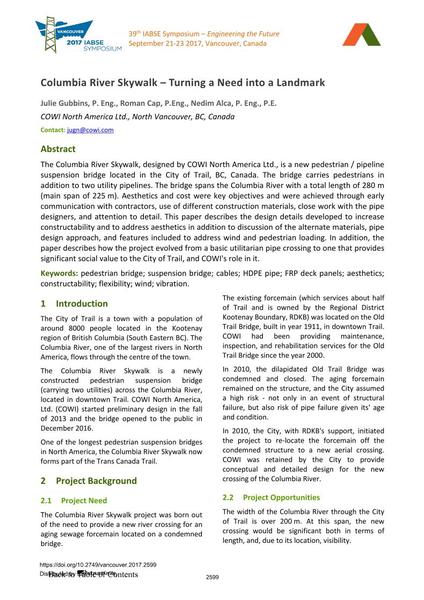Columbia River Skywalk – Turning a Need into a Landmark

|
|
|||||||||||
Bibliographic Details
| Author(s): |
Julie Gubbins
(COWI North America Ltd., North Vancouver, BC, Canada)
Roman Cap (COWI North America Ltd., North Vancouver, BC, Canada) Nedim Alca (COWI North America Ltd., North Vancouver, BC, Canada) |
||||
|---|---|---|---|---|---|
| Medium: | conference paper | ||||
| Language(s): | English | ||||
| Conference: | IABSE Symposium: Engineering the Future, Vancouver, Canada, 21-23 September 2017 | ||||
| Published in: | IABSE Symposium Vancouver 2017 | ||||
|
|||||
| Page(s): | 2599-2606 | ||||
| Total no. of pages: | 8 | ||||
| Year: | 2017 | ||||
| DOI: | 10.2749/vancouver.2017.2599 | ||||
| Abstract: |
The Columbia River Skywalk, designed by COWI North America Ltd., is a new pedestrian / pipeline suspension bridge located in the City of Trail, BC, Canada. The bridge carries pedestrians in addition to two utility pipelines. The bridge spans the Columbia River with a total length of 280 m (main span of 225 m). Aesthetics and cost were key objectives and were achieved through early communication with contractors, use of different construction materials, close work with the pipe designers, and attention to detail. This paper describes the design details developed to increase constructability and to address aesthetics in addition to discussion of the alternate materials, pipe design approach, and features included to address wind and pedestrian loading. In addition, the paper describes how the project evolved from a basic utilitarian pipe crossing to one that provides significant social value to the City of Trail, and COWI's role in it. |
||||
| Keywords: |
aesthetics wind pedestrian bridge suspension bridge flexibility ropes cables vibration constructability HDPE pipe FRP deck panels
|
||||
